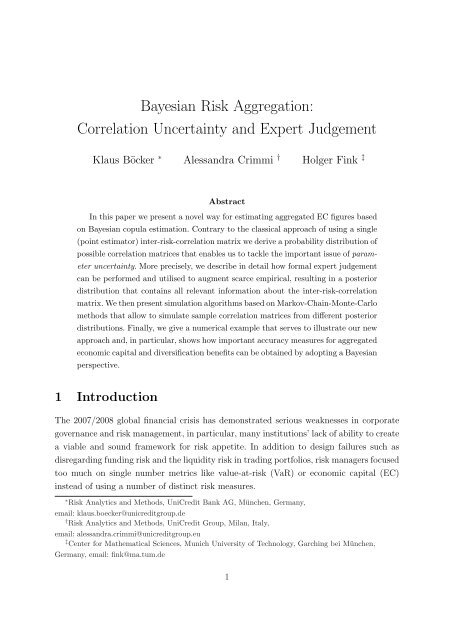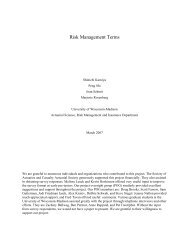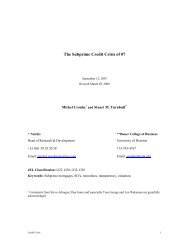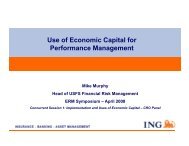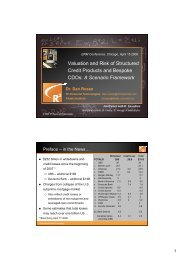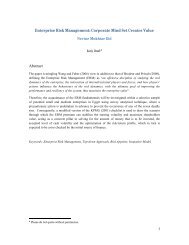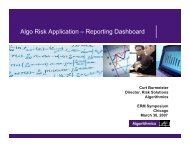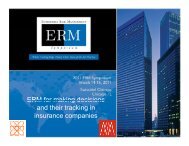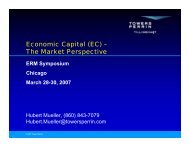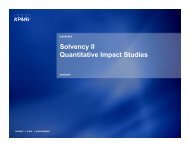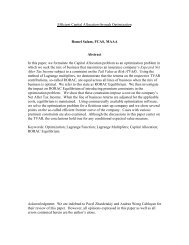Bayesian Risk Aggregation: Correlation ... - ERM Symposium
Bayesian Risk Aggregation: Correlation ... - ERM Symposium
Bayesian Risk Aggregation: Correlation ... - ERM Symposium
You also want an ePaper? Increase the reach of your titles
YUMPU automatically turns print PDFs into web optimized ePapers that Google loves.
<strong>Bayesian</strong> <strong>Risk</strong> <strong>Aggregation</strong>:<br />
<strong>Correlation</strong> Uncertainty and Expert Judgement<br />
Klaus Böcker ∗ Alessandra Crimmi † Holger Fink ‡<br />
Abstract<br />
In this paper we present a novel way for estimating aggregated EC figures based<br />
on <strong>Bayesian</strong> copula estimation. Contrary to the classical approach of using a single<br />
(point estimator) inter-risk-correlation matrix we derive a probability distribution of<br />
possible correlation matrices that enables us to tackle the important issue of param-<br />
eter uncertainty. More precisely, we describe in detail how formal expert judgement<br />
can be performed and utilised to augment scarce empirical, resulting in a posterior<br />
distribution that contains all relevant information about the inter-risk-correlation<br />
matrix. We then present simulation algorithms based on Markov-Chain-Monte-Carlo<br />
methods that allow to simulate sample correlation matrices from different posterior<br />
distributions. Finally, we give a numerical example that serves to illustrate our new<br />
approach and, in particular, shows how important accuracy measures for aggregated<br />
economic capital and diversification benefits can be obtained by adopting a <strong>Bayesian</strong><br />
perspective.<br />
1 Introduction<br />
The 2007/2008 global financial crisis has demonstrated serious weaknesses in corporate<br />
governance and risk management, in particular, many institutions’ lack of ability to create<br />
a viable and sound framework for risk appetite. In addition to design failures such as<br />
disregarding funding risk and the liquidity risk in trading portfolios, risk managers focused<br />
too much on single number metrics like value-at-risk (VaR) or economic capital (EC)<br />
instead of using a number of distinct risk measures.<br />
∗<strong>Risk</strong> Analytics and Methods, UniCredit Bank AG, München, Germany,<br />
email: klaus.boecker@unicreditgroup.de<br />
† <strong>Risk</strong> Analytics and Methods, UniCredit Group, Milan, Italy,<br />
email: alessandra.crimmi@unicreditgroup.eu<br />
‡ Center for Mathematical Sciences, Munich University of Technology, Garching bei München,<br />
Germany, email: fink@ma.tum.de<br />
1
Economic Capital [EUR mn] Dec 31, 2009<br />
Market risk 3, 564<br />
Credit <strong>Risk</strong> 9, 981<br />
Operational risk 2, 612<br />
Business risk 1, 666<br />
Total EC 17, 823<br />
Table 1.1: Prototypical example of a bank’s Pillar 3 report of EC for different risk types as well as the<br />
aggregated EC. Given no further information about the measurement error, the presented number for<br />
aggregated EC suggests an absolute uncertainty of ±1 mn EUR, corresponding to a relative uncertainty<br />
of 0.0056 %.<br />
Assessing risk by means of a single number only becomes even more of a problem<br />
if quantitative mathematical models are used without any adjustment for model uncer-<br />
tainty. Much too often in risk management practices, results are calculated to a fictitious<br />
degree of accuracy, which is greater than is warranted by the data used in the calculation.<br />
As a typical example, look at the—of course illustrative but nevertheless realistic—EC<br />
figures for different risk types and total aggregated EC presented in Table 1.1. Recall<br />
that the purpose of EC is to capture extreme losses and therefore it is measured at high<br />
confidence levels typically in a range between 99.50 % and 99.98 %. The way the figures<br />
are presented in Table 1.1 suggests that the aggregated EC, which is a key element in the<br />
practical implementation of a bank’s risk appetite framework has been determined with<br />
the incredible relative precision 1 of ±5.6 × 10 −5 .<br />
Such pseudo accuracy leads to a wrong subjective risk perception and may create a<br />
dangerous overconfidence of the decision maker. In general, the feeling of greater security<br />
tempts people to be more reckless and, in the context of risk management, leads deci-<br />
sion makers to concentrate mainly on the upside opportunity of markets and to neglect<br />
downside risk. One of the main concerns in connection with risk aggregation is of whether<br />
and to which extent diversification benefits between different risk types can be identified.<br />
Apart from the very simple approach of adding-up all EC estimates for each risk category<br />
or business line one can distinguish between top-down or modular approaches on the one<br />
hand and bottom-up or multi-factor simulation approaches on the other, cf. for instance<br />
Saita [24] for further information and references about principles of risk aggregation.<br />
Bottom-up approaches basically model all the bank’s real and financial variables in-<br />
cluding assets, liabilities and interest sensitive off-balance sheet items simultaneously, see<br />
for e.g. Kretzschmar, McNeil, and Kirchner [16]. This allows to capture gains and losses at<br />
1 As an illustration, the same relative error is obtained when computing a distance of about 18 meters<br />
while maintaining an accuracy of 1 mm.<br />
2
the level of individual instruments or positions without the need for creating artificial risk<br />
silos. Such sophisticated approaches are particularly important for market and credit risk,<br />
which are highly related and inextricably linked with each other, see e.g. the Research<br />
Task Force of the Basel Committee on Banking Supervision [2] and Hartmann, Pritsker,<br />
and Schuermann [14] for more about the interaction of market and credit risk.<br />
While financial institutions and supervisors are seeking for flexible bottom-up methods<br />
for the aggregation of market and credit risk, conceptual difficulties remain with respect<br />
to other risk types such as operational risk and business risk. As a matter of fact, banks<br />
are currently still favoring simpler top-down methods when computing their aggregated<br />
EC as pointed out in IFRI/CRO Forum [15]. According to this survey the most popular<br />
method in practice is the aggregation-by-risk-type approach where stand-alone risk figures<br />
of different risk types are combined in some way to obtain the desired aggregated EC. In<br />
a similar, more recent survey of the Basel Committee [3] it is reported that “there is no<br />
established set of best practices concerning risk aggregation in the industry.” From all this,<br />
it can be expected that for quite a long time hybrid approaches that at least partially rely<br />
on an inter-risk-correlation matrix, will heavily influence market practices.<br />
The simplest form of risk aggregation expresses the dependence between different risk<br />
types by an inter-risk-correlation matrix R, and its estimation and calibration is a core<br />
problem for the calculation of total EC in practice. A standard approach is to model the<br />
dependence structure between risk types by a distributional copula, see e.g. the references<br />
in Böcker [5]. Estimates for inter-risk-correlations differ significantly within the industry.<br />
The IFRI/CRO Forum [15] points out that“correlation estimates used vary widely, to<br />
an extent that is unlikely to be solely attributable to differences in business mix.” This<br />
obviously shows that the estimation of inter-risk correlations is afflicted with high uncer-<br />
tainties. One reason for this is that very often reliable data are scarce and do not cover<br />
long historical time periods. Therefore, inter-risk correlations are approximated by the co-<br />
movement of asset price indices or similar proxies of which, it is hoped, are representative<br />
for these risk types. As a consequence thereof, a reliable and robust statistical estimate of<br />
the inter-risk-correlation matrix is often not possible and it is necessary to draw on expert<br />
opinions. This has recently also been acknowledged by the Committee of European Bank-<br />
ing Supervisors in their recent consultation paper [8], where they explicitly distinguish<br />
statistical techniques versus expert judgements.<br />
Our work makes two novel contributions for estimating aggregated EC within an<br />
aggregation-by-risk-type framework. First, we explicitly address the existence of param-<br />
eter uncertainty associated with the inter-risk-correlation matrix. Second, we present a<br />
sophisticated method for assessing inter-risk correlations (more precisely, the Gaussian<br />
copula parameters) by means of expert judgement. To illustrate our approach, we calcu-<br />
3
late aggregated EC for the same sample portfolio already used in Böcker [5], consisting<br />
of 10 % market risk, 61 % credit risk, 14 % operational risk, and 15 % business risk in<br />
terms of 99.95 % EC. Here, however, we make an assumption which is key to what fol-<br />
lows, namely that as a consequence of all the uncertainties a bank’s inter-risk-correlation<br />
matrix cannot be considered as a fixed parameter of the risk-aggregation model but should<br />
rather be treated as a random parameter. Hence, the inter-risk-correlation matrix R (or,<br />
more generally, the parameters of the copula) is described by a distribution function,<br />
which is referred to as the posterior distribution. This distribution comprises information<br />
stemming from empirical data X (e.g. time series of risk proxies representative for each<br />
risk type) as well as from expert judgement.<br />
This paper is organised as follows. In Section 2 we will briefly recap the “classical”<br />
aggregation-by-risk-type approach using a fixed Gaussian copula and also introduce the<br />
portfolio that serves as an illustrative example. Section 3 then describes the construction of<br />
the prior and posterior distribution of the inter-risk-correlation matrix by considering the<br />
different pair correlations separately. For two specific models (the beta and the triangular<br />
models) we suggest a Markov-Chain-Monte-Carlo (MCMC) algorithms that can easily be<br />
used to sample a set of correlation matrices from the posterior. In Section 4 we discuss a<br />
numerical example of risk aggregation and, finally, Section 5 is devoted to the important<br />
issue of how inter-risk correlations may be estimated using expert knowledge.<br />
2 Classical copula aggregation<br />
A d-dimensional distributional copula C is a d-dimensional distribution function on [0, 1] d<br />
with uniform marginals. Among all copulas discussed in the literature, maybe those most<br />
frequently used for risk aggregation are the Gaussian copula and the t copula. The impor-<br />
tance of copulas for financial risk management is essentially a result of Sklar’s theorem,<br />
stating that every multivariate distribution function can be separated into their marginal<br />
distribution functions and a copula. Therefore, copulas allow for a separate modelling of<br />
the marginal distribution functions of distinct risk types on the one hand and their depen-<br />
dence structure (i.e. the copula) on the other. Distributional copulas have been frequently<br />
applied to risk aggregation e.g. Dimakos & Aas [9], Rosenberg & Schuermann [23], Ward<br />
& Lee [26], or Brockmann & Kalkbrener [6].<br />
In the sequel, we summarise some properties of the Gaussian copula, see Cherubini,<br />
Luciano, and Vecchiato [7] for more details. Let Φ denote the standard univariate normal<br />
distribution function, Φ d R<br />
the standard multivariate normal distribution function with<br />
d × d correlation matrix R, and (u1, . . . , ud) ∈ [0, 1] d . Then, the distribution function of<br />
4
the d-dimensional Gaussian copula is given by<br />
C d R(u1, . . . , ud) = Φ d R(Φ −1 (u1), . . . , Φ −1 (ud)) (2.1)<br />
where Φ −1 (·) denotes the inverse of the standard normal distribution function. The density<br />
of the d-dimensional Gaussian copula can be written as<br />
c d 1<br />
−<br />
R(u1, . . . , ud) = det(R) 2 exp<br />
with ξ = (Φ −1 (u1), . . . , Φ −1 (ud)) ′ and identity matrix Id.<br />
<br />
− 1<br />
2 ξ′ (R −1 − Id)ξ<br />
<br />
(2.2)<br />
We now turn to the estimation of the Gaussian copula which is usually done by<br />
maximising the corresponding likelihood function. Suppose x1, . . . , xn is an n-sample of<br />
d×1 mutually independent observations that are identically distributed. In the context of<br />
inter-risk aggregation each marginal component of xj, j = 1, . . . , n, represents a suitable<br />
risk driver or loss proxy representative for a different risk type. Specifically, assuming a<br />
Gaussian copula model means that all components of xj, j = 1, . . . , n, have a Gaussian<br />
dependence structure.<br />
After transforming the sample data xj into variates uj with uniform marginals (e.g.<br />
using order statistics or parametric distribution functions), we obtain for the likelihood<br />
of the Gaussian copula<br />
1<br />
−<br />
l(R|ξ1, . . . , ξn) ∝ det(R) 2 n exp<br />
<br />
− 1<br />
2 tr(R−1 <br />
B) . (2.3)<br />
Here, the d×d symmetric, positive semidefinite matrix B is the sample covariance matrix<br />
of the data after transformation to standard Normal marginals, i.e.<br />
B = 1<br />
n<br />
n<br />
j=1<br />
ξ jξ ′<br />
j with ξ j = (Φ −1 (u1j), . . . , Φ −1 (udj)) ′ , (2.4)<br />
which is also the global maximum of the likelihood function (2.3), see e.g. Press [20], p.<br />
183. Without loss of generality, we may always use a standardised sample ξ j that has<br />
exactly unit sample variance so that B equals the sample correlation matrix. Then we<br />
finally obtain the MLE of the Gaussian copula parameter as<br />
ˆR = 1<br />
n<br />
n<br />
j=1<br />
ξ jξ ′<br />
j .<br />
After the matrix ˆ R has been determined, one can start risk-type aggregation. As men-<br />
tioned in the introduction, we adopt the portfolio used in Böcker [5] consisting of 10 %<br />
market risk, 61 % credit risk, 14 % operational risk, and 15 % business risk, representing<br />
5
<strong>Risk</strong> Distribution function Parameters<br />
<br />
MR F (x) = Fν , x ∈ R µ = 0, σ = 2.18, ν = 10<br />
x−µ<br />
σ<br />
CR F (x) = X = 2338.64,<br />
Φ √<br />
√ϱ<br />
1<br />
−1 x<br />
1 − ϱ Φ ( X ) − Φ−1 (p) , x > 0 p = 0.3%, ϱ = 8%<br />
OR F (x) = Φ ln x−µ<br />
σ<br />
BR F (x) = Φ x−µ<br />
σ<br />
, x > 0 µ = −0.893, σ = 1.089<br />
, x ∈ R µ = 0, σ = 4.56<br />
Table 2.2: Marginal distributions for market risk (MR), credit risk (CR), operational risk (OR), and<br />
business risk (BR), where Fν is the Student-t distribution function with ν degrees of freedom and Φ<br />
is the standard normal distribution function. MR follows a scaled Student-t and CR is described by a<br />
Vasicek distribution with total exposure X, uniform asset correlation ϱ, and average default probability<br />
p. Operational risk (OR) is assumed to be lognormally distributed and business risk (BR) is modelled<br />
by a normal distribution. The parameters for the distribution functions are chosen so that MR, CR, OR,<br />
and BR absorb 10, 61, 14, and 15 units of EC at 99.95 % confidence level. Finally, only credit risk and<br />
operational risk have non-zero expected losses of about 7.0 and 0.7, respectively.<br />
an industry average obtained from large banks reported in IFRI/CRO Forum [15], Fig-<br />
ure 16. Furthermore, we assume that EC for each risk type was calculated at confidence<br />
level of 99.95 %, time horizon of one year, and that the marginal distribution functions are<br />
as in Table 2.2. Now, assuming that the inverses F −1<br />
i (·), i =, 1, . . . , d, of all marginal risk<br />
type distribution functions Fi(·) exist, classical risk aggregation with a Gaussian copula<br />
is straight-forward. In a first step, one simulates a large number N of mutually indepen-<br />
dent d × 1 vectors u1, . . . , uN from the Gaussian copula C d ˆ R . Note that by definition for<br />
all j = 1, . . . , N the marginal components {u1j, . . . , udj} of the vectors uj are uniformly<br />
distributed with a Gaussian dependence structure. In a second step, all marginal components<br />
are transformed according to F −1<br />
i (uij), i = 1, . . . , d, j = 1, . . . , N. Since copulas<br />
are invariant under strictly increasing transformations, the dependence structure between<br />
{F −1<br />
1 (u1j), . . . , F −1<br />
d (udj)}j=1,...,N is the same as between {u1j, . . . , udj}j=1,...,N, that is a<br />
Gaussian one. Finally, a simulated N-sample of aggregated EC can be computed through<br />
d −1<br />
i Fi (uij) <br />
j=1,...,N .<br />
3 <strong>Bayesian</strong> risk aggregation<br />
3.1 Construction of the inter-risk-correlation prior<br />
In the <strong>Bayesian</strong> approach for risk-type aggregation, one has to find a suitable prior for the<br />
inter-risk-correlation matrix R of the Gaussian copula. This prior quantifies the available<br />
6
expert knowledge regarding the inter-risk-correlation matrix in probabilistic form. Since<br />
our example portfolio consists of d = 4 risk types, it is sufficient to consider 4×4 correlation<br />
matrices R, which can be identified with a 6-dimensional real vector by<br />
⎛<br />
⎞<br />
⎜<br />
R = ⎜<br />
⎝<br />
1 r1 r2 r3<br />
· 1 r4 r5<br />
· · 1 r6<br />
· · · 1<br />
⎟<br />
⎠ ←→ (r1, r2, r3, r4, r5, r6), ri ∈ [−1, 1], 1 ≤ i ≤ 6. (3.1)<br />
The most commonly used prior model for a covariance matrix Σ is the inverse-Wishart<br />
distribution, see e.g. Press [20]. Since every covariance matrix Σ is related to a correlation<br />
matrix R by<br />
Σ = S 1/2 R S 1/2 , (3.2)<br />
where S = diag(σ11, σ22, . . .) and σjj are the diagonal elements of Σ, the inverse-Wishart<br />
prior can also be used to construct a prior for the correlation matrix.<br />
The inverse-Wishart-based prior for the inter-risk-correlation matrix allows only for<br />
one single degrees of freedom parameter ν to express prior beliefs (and thus the level of<br />
uncertainty) about R. In practice, however, the amount of available expert information<br />
for different pair correlations ri, i = 1, . . . , 6, may significantly depend on the risk-type<br />
combinations. Another drawback of the inverse-Wishart distribution is that the resulting<br />
prior for R cannot easily be estimated by means of expert judgement. Note, that the<br />
prior distribution for R is calculated from the inverse-Wishart prior for Σ through trans-<br />
formation (3.2), which rarely yields a prior distribution that can easily be specified by<br />
expert elicitation. All this leads to the conclusion that the inverse-Wishart based prior is<br />
inadequate for our purpose and that we have to construct a more flexible prior for R.<br />
Thus we have decided to use a kind of “bottom-up” approach when building the prior<br />
distribution for the inter-risk-correlation matrix. In a first step, prior information for each<br />
component ri, i = 1, . . . , 6, of R is separately modelled by one-dimensional distributions<br />
with Lebesgue densities πi(ri), i = 1, . . . , 6. This yields a distribution of symmetric, real-<br />
valued matrices with diagonal elements equal to one. In a second step we restrict to<br />
those matrices preserving the positive semidefiniteness of the correlation matrix. Hence,<br />
denoting the space of all 4-dimensional correlation matrices by R 4 , a possible density for<br />
the correlation matrix prior can be written as<br />
π(R) = <br />
πi(ri) 1 {R∈R4 }. (3.3)<br />
1≤i≤6<br />
The indicator function 1{·} ensures that the matrices are positive definite and thus are<br />
proper correlation matrices, and also introduces a dependence structure among the ri for<br />
i = 1, . . . , 6.<br />
7
Pairwise correlation priors As we describe in more detail in Section 5, a well-<br />
established approach for the subjective determination of a prior density is by matching a<br />
given functional form. The shape of the prior reflects the amount and the quality of the<br />
available information and should match the experts’ beliefs as closely as possible.<br />
As risk managers are concerned about unreasonable and possibly incorrect diversifi-<br />
cation benefits, it is normally assumed that correlations between different risk types are<br />
non-negative. Such a boundary condition for the correlation matrix can easily and natu-<br />
rally be modelled within the <strong>Bayesian</strong> framework by considering only pairwise priors πi<br />
that have support in [0,1].<br />
Example 3.1. [Uniform prior]<br />
Assume that the experts are totally uninformed about the possible values of the single<br />
pair correlations ri for i = 1, . . . , 6. Consequently, we may want to take all values of ri as<br />
equally likely and, in consideration of the general restriction ri ∈ [0, 1], a natural diffuse<br />
prior is the uniform distribution<br />
πi(ri) ∝ 1{0
Example 3.3. [Triangular distributed prior]<br />
An alternative family of useful prior distributions for a correlation parameter is the sym-<br />
metric triangular distribution giving values between αi and βi with −1 ≤ αi < βi ≤ 1.<br />
Then, the prior density for all ri, i = 1, . . . , 6, is of the form<br />
T (ri|αi, βi) = 4 βi − ri<br />
(βi − αi) 2 1{(αi+βi)/2
Gibbs sampling One possibility is to simultaneously simulate a 6-dimensional Markov<br />
chain of the vector of pair correlations (r1, . . . , r6), e.g. by using a Metropolis-Hastings<br />
algorithm. This would necessitate a six-dimensional proposal distribution and our experi-<br />
ence is that the convergence of the chain often becomes very slow, especially when more<br />
than only four risk types are considered. An alternative and convenient method is Gibbs<br />
sampling, which allows to circumvent high dimensionality by simulating componentwise<br />
using the full conditionals of (3.8) with respect to all but one pair correlation ri. More<br />
precisely, up to a constant, the full conditional posterior distributions for i = 1, . . . , 6 can<br />
be written as<br />
p(ri|rj, i = j) ∝ det Ri(ri) − n<br />
<br />
2 exp − 1<br />
2 trRi(ri) −1 B <br />
πi(ri) 1 {Ri(ri)∈R4 } , ri ∈ [0, 1](3.9)<br />
where Ri(·) ≡ R(·|r1, . . . , ri−1, ri+1, . . . , r6) is the correlation matrix obtained from R<br />
by fixing all but the i-th pair correlations. These one-dimensional distributions are still<br />
complex and not at all standard. However, an independent Metropolis-Hastings algorithm<br />
where the proposal density is independent of the current chain value works quite well for<br />
our set-up, see details below.<br />
The Gibbs sampler generates an autocorrelated Markov chain of vectors (r (t)<br />
1 , . . . , r (t)<br />
6 )t=0,1,2,...<br />
with stationary distribution p(R|ξ 1, . . . , ξ n) given by equation (3.8). The updating of the<br />
t-th component of the chain to the (t+1)-th component works componentwise by sampling<br />
from the one-dimensional full conditionals (3.9):<br />
(1) r (t+1)<br />
1<br />
(2) r (t+1)<br />
2<br />
.<br />
(6) r (t+1)<br />
6<br />
∼ p(r1|r (t)<br />
2 , r (t)<br />
3 , . . . , r (t)<br />
6 ),<br />
∼ p(r2|r (t+1)<br />
1 , r (t)<br />
3 , . . . , r (t)<br />
6 ),<br />
∼ p(r6|r (t+1)<br />
1<br />
, r (t+1)<br />
2<br />
, . . . , r (t+1)<br />
5 ).<br />
The Gibbs sampler converges in our situation by construction, see Section 10.2 of<br />
Robert and Casella [21]. Therefore, after a sufficiently long burn-in period of b iterations,<br />
the matrices R (t)<br />
b
The Metropolis-Hastings algorithm requires an appropriate proposal density. In gen-<br />
eral, the Metropolis-Hastings algorithm works more successfully when the proposal density<br />
is at least approximately similar to the target density, i.e. the full conditionals (3.9). As-<br />
suming that the length n of the empirical time series is relatively short, we may suppose<br />
that the shape of the full conditional posteriors (3.9) are mainly impacted by the full<br />
conditionals of the correlation matrix priors, i.e. by<br />
π(ri|rj, i = j) ∝ πi(ri) 1 {Ri(ri)∈R 4 }, i = 1, . . . , 6, ri ∈ [0, 1] . (3.10)<br />
Therefore, when deploying the one-dimensional independent Metropolis-Hastings al-<br />
gorithm to sample from (3.9), it may be justified to chose the full conditionals (3.10) as<br />
proposal densities. An alternative proposal are uniform distributions. It should be men-<br />
tioned that the question regarding which proposal distribution works best can only be<br />
answered in the context of the concrete data at hand. In our exercise below, we found that<br />
proposals of the form (3.10) are superior to a uniform distribution when beta distributed<br />
priors are used (Exercise 3.2). However, in case of triangular shaped priors (Exercise 3.3)<br />
either a uniform distribution or the full conditional priors are suitable proposal densities<br />
and lead to good convergence of the MCMC simulation (see Appendix 6.1).<br />
When sampling ri, i = 1, . . . , 6, from (3.9) one has to account for the fact that the<br />
resulting matrix R must be positive semidefinite. In order to achieve a maximum com-<br />
putational efficiency, it would be good to know what values of ri, given all the other<br />
correlations rj, j = i, keep R positive semidefinite. Following Barnard et al. [1] we remark<br />
that the indicator function 1 {Ri(ri)∈R 4 } whose evaluation involves computations of deter-<br />
minants can be rewritten as 1{ri∈[ai(rj,j=i),bi(rj,j=i)]} for all i = 1, . . . , 6. Here, ai(rj, j = i)<br />
and bi(rj, j = i) are the roots of the two-grade polynomial det(Ri(ri)) = 0 with Ri(·) as<br />
defined in (3.9). Therefore, sampling from the full conditionals (3.9) reduces to sampling<br />
from the related truncated distributions with a truncation intervals [ai(·), bi(·)] that can<br />
easily be calculated in closed-form.<br />
Before we specify the simulation algorithms for the two models of Examples 3.2 and 3.3,<br />
we should mention that our independent Metropolis-Hastings algorithm always converges<br />
due to compact support of proposal and posterior densities, cf. Theorem 7.8 of Robert<br />
and Casella [21].<br />
Example 3.4. [Beta distributed prior (continued)]<br />
We use the beta distributed pairwise priors introduced in Example 3.2 and thus the prior<br />
for the correlation matrix follows from (3.3) to be<br />
π(R) = <br />
1≤i≤6<br />
Be(ri|αi, βi) 1 {R∈R 4 }. (3.11)<br />
11
As already mentioned above, we take as proposal distributions for the independent Metropolis-<br />
Hastings algorithm the full conditionals of (3.11), which can be written as<br />
π(ri|rj, j = i) ∝ Be(ri|αi, βi) 1{ri∈[ai(rj,j=i),bi(rj,j=i)]} , i = 1, . . . , 6 , (3.12)<br />
where ai(·) and bi(·) are the solutions to det(Ri(ri)) = 0. We now can specify the whole<br />
simulation algorithm as follows:<br />
(I) Chose a starting correlation matrix R (0) ←→ (r (0)<br />
1 , . . . , r (0)<br />
6 ) and set t = 0.<br />
(II) Set (z1, . . . , z6) = (r (t)<br />
1 , . . . , r (t)<br />
6 ). For i = 1, . . . , 6 do:<br />
(1) Set k = 0, x (k) = zi and define R i [·] ≡ R · |zj, j = i .<br />
(2) Generate a proposal y ∼ π(·|zj, j = i) according to (3.12).<br />
(3) Calculate the update probability δ as<br />
i<br />
R [y]<br />
δ = min 1, det<br />
R i [x (k) −<br />
]<br />
n <br />
2<br />
exp − 1<br />
2 trR i [y] −1 − R i [x (k) ] −1 B <br />
.<br />
(4) Take x (k+1) =<br />
<br />
y, with probability δ,<br />
x (k) , else.<br />
(5) If k = IMH − 1 then stop and set zi = x (k+1) , else set k = k + 1 and go to (2).<br />
(III) Set (r (t+1)<br />
1<br />
, . . . , r (t+1)<br />
6 ) = (z1, . . . , z6).<br />
If t = IGibbs − 1 then stop, else set t = t + 1 and go to (II).<br />
IGibbs and IMH determine the number of steps of the Gibbs sampler and the independent<br />
Metropolis-Hastings algorithms, respectively. <br />
Example 3.5. [Triangular distributed prior (continued)]<br />
In case of the triangular priors (3.6) of Example 3.3 we decided to use uniformly distributed<br />
proposals. The simulation can be done using the following algorithm:<br />
(I) Chose a starting correlation matrix R (0) ←→ (r (0)<br />
1 , . . . , r (0)<br />
6 ) and set t = 0.<br />
(II) Set (z1, . . . , z6) = (r (t)<br />
1 , . . . , r (t)<br />
6 ). For i = 1, . . . , 6 do:<br />
(1) Set k = 0, x (k) = zi and define R i [·] ≡ R · |zj, j = i .<br />
(2) Generate a proposal y ∼ 1 {R i [·]∈R 4 } = 1{·∈[ai(zj,j=i),bi(zj,j=i)]}.<br />
(3) Calculate the update probability δ as<br />
i<br />
R [y]<br />
δ = min 1, det<br />
R i [x (k) −<br />
]<br />
n <br />
2<br />
exp − 1<br />
2 trR i [y] −1 − R i [x (k) ] −1 B T (y|αi, βi)<br />
T (x (k) <br />
.<br />
|αi, βi)<br />
12
(4) Take x (k+1) =<br />
<br />
y, with probability δ,<br />
x (k) , else.<br />
(5) If k = IMH − 1 then stop and set zi = x (k+1) , else set k = k + 1 and go to (2).<br />
(III) Set (r (t+1)<br />
1<br />
, . . . , r (t+1)<br />
6 ) = (z1, . . . , z6).<br />
If t = IGibbs − 1 then stop, else set t = t + 1 and go to (II).<br />
4 A simulation study of aggregated EC<br />
We now illustrate our new approach by means of a fictitious numerical example. We<br />
assume that the empirical correlation matrix B of the Gaussian copula as defined in (2.4)<br />
is given by<br />
⎛<br />
⎜ MR<br />
⎜<br />
B = ⎜ CR<br />
⎜<br />
⎝ OR<br />
MR<br />
1<br />
0.66<br />
0.30<br />
CR<br />
0.66<br />
1<br />
0.30<br />
OR<br />
0.30<br />
0.30<br />
1<br />
⎞<br />
BR<br />
⎟<br />
0.58 ⎟<br />
0.67 ⎟ ,<br />
⎟<br />
0.60 ⎠<br />
(4.1)<br />
BR 0.58 0.67 0.60 1<br />
which are actually the benchmark inter-risk correlations reported in the IFRI/CRO survey<br />
[15], Figure 10. This matrix was also used in the simulation study in Böcker [5]. Since this<br />
matrix is not derived from actual risk proxy data, we have to assume a fictitious value for<br />
the time series length n in the likelihood function (2.3). We chose it to be n = 10, think<br />
e.g. of 2.5 years of quarterly data.<br />
In addition to the empirical information above we assume subjective prior knowledge<br />
in order to completely specify the posterior distribution (3.8). Let us suppose that expert<br />
elicitation as explained in Section 5 has been performed to estimate the mean values µi<br />
and standard deviations σi of all pair correlations ri, i = 1, . . . , 6, which by relationships<br />
(3.5) and (3.7) can be used to compute the hyperparameters αi and βi. The assumed<br />
outcome of the expert judgement is shown in Table 4.3 for all six pair correlations. In<br />
addition, Figures 4 and 5 in the Appendix depict also the prior densities parameterised<br />
according to Table 4.3 together with the empirical estimates (4.1).<br />
For the simulation of the posterior distribution of the inter-risk-correlation matrix we<br />
ran the algorithms described in Examples 3.4 and 3.5 for the beta and the triangular<br />
model, respectively. The starting value R (0) is chosen as the empirical matrix (4.1). Fur-<br />
thermore, for the triangular (beta) model we set IMH = 1, 000 (1, 000) for each Metropolis-<br />
Hastings step within the Gibbs algorithm and IGibbs = 100, 000 (300, 000). In the trian-<br />
gular model we used only the last 9,000 iterations of the chain for posterior analysis and<br />
13
<strong>Correlation</strong>s Moments Triangular priors Beta priors<br />
i µi σi αi βi αi βi<br />
1 MR-CR 0.58 0.067 0.416 0.744 30.894 22.372<br />
2 MR-OR 0.35 0.06 0.203 0.497 21.768 40.426<br />
3 MR-BR 0.65 0.065 0.491 0.809 34.350 18.496<br />
4 CR-OR 0.25 0.06 0.103 0.379 12.771 38.313<br />
5 CR-BR 0.6 0.067 0.436 0.764 31.478 20.986<br />
6 OR-BR 0.68 0.067 0.516 0.844 32.282 15.192<br />
Table 4.3: Mean values and standard deviations for the six pair correlations ri, i = 1, . . . , 6, as it could be<br />
obtained by expert judgement. The associated hyperparameters (αi, βi) for the beta model of Example<br />
3.2 and the triangular model of Example 3.3 are derived from (3.5) and (3.7), respectively.<br />
Beta<br />
MR-CR MR-OR MR-BR CR-OR CR-BR OR-BR<br />
Posterior Mean 0.590 0.347 0.667 0.240 0.623 0.718<br />
Posterior Std. 0.066 0.059 0.062 0.059 0.064 0.058<br />
Posterior Mean 0.595 0.346 0.677 0.237 0.628 0.721<br />
Triangular Posterior Std. 0.068 0.062 0.065 0.062 0.067 0.061<br />
Table 4.4: Mean values and standard deviations of the simulated marginal posterior distributions for the<br />
six pair correlations ri, i = 1, . . . , 6.<br />
aggregating EC. In case of the beta model, we first took the last 27,000 iterations from<br />
which we then picked only every third value in order to reduce autocorrelation of the<br />
chain. Hence, in both models we finally came up with 9,000 inter-risk-correlation matrices<br />
sampled from the posterior distribution. Further remarks on convergence diagnostics of<br />
our method can be found in the Appendix.<br />
Table 4.4 shows the mean values and the standard deviations of the marginal pos-<br />
terior distributions. The posterior means are different from the pure empirical estimates<br />
given in (4.1) because of the additional consideration of expert prior knowledge. Moreover,<br />
we see that in our case the two different prior models seem to have only little influence<br />
on the posterior distributions. Figures 4 and 5 graphically compare the marginal poste-<br />
rior distributions obtained from the proposed MCMC algorithm with the pairwise prior<br />
distributions both for the beta and triangular model.<br />
To aggregate EC we now use the Gaussian copula model, however, instead of applying a<br />
fixed correlation matrix (such as B in (4.1)) we use different correlation matrices randomly<br />
selected from the simulated Markov chain (after discarding the burn-in sample). In doing<br />
so, we are able to take the uncertainty of the inter-risk-correlation matrix correctly into<br />
14
Aggregated Economic Capital at 99.95 % CL (Gaussian copula model)<br />
Sum Fixed correlation B Beta prior model Triangular prior model<br />
100 79.57 77.88 77.81<br />
Table 4.5: Aggregated EC at confidence level of 99.95 % and time horizon of one year for a standard<br />
Gaussian copula model with fixed matrix, and the <strong>Bayesian</strong> copula models with either beta or triangular<br />
priors as described in the text. The portfolio consisting of market, credit, operational, and business risk<br />
is specified in Table 2.2.<br />
36 37 38 39 40<br />
Aggregated EC at 99 CLBeta Model<br />
36 37 38 39 40<br />
Aggregated EC at 99 CLTriangular Model<br />
Figure 1: Histograms for the aggregated EC at confidence level of 99 % for the beta model (left) and the<br />
triangular model (right). The posterior mean and the 95 % percent credible interval can be calculated to<br />
37.89 [36.63, 39.24] and 37.90 [36.59, 39.27] for the beta and triangular model, respectively, corresponding<br />
to a relative uncertainty of the aggregated EC of about 7 %.<br />
account. Results for the beta and triangular prior models as well as for the “standard”<br />
approach using one fixed matrix B are given in Table 4.5. The posterior distribution of<br />
the inter-risk-correlation matrix implies also a posterior distribution for the aggregated<br />
EC which can be used to analyse the uncertainty of a bank’s aggregated EC figure and<br />
thus also the diversification benefit due to risk-type dependence. Particularly useful are<br />
graphical methods that depict the posterior density of the aggregated EC at confidence<br />
level κ, denoted by pEC(κ)(·), e.g. histograms (as shown in Figure 1) or “uncertainty” plots<br />
like in Figure 2. The latter illustrates the density pEC(κ)(·) as a function of the confidence<br />
level κ by means of a gray-level intensity plot. Other useful measures of uncertainty<br />
are credible intervals, which are direct probability statements about model parameters or<br />
functions of it given the observed data (see e.g. Berger [4]). We calculated the 95 % percent<br />
15
Figure 2: Uncertainty plot for the aggregated EC if the priors for the pair correlations are described by<br />
triangular distributions as in Example 3.3. Lighter (darker) shaded regions of the plot indicate a lower<br />
(higher) posterior density of the aggregated EC.<br />
credible interval for the EC distributions given in Figure 1. In case of the beta priors we<br />
obtain [36.63, 39.24] and for the triangular shaped priors a calculation yields [36.59, 39.27].<br />
Obviously, in our numerical example, one can see from Table 4.5 and Figure 1 that the<br />
impact of differently shaped priors (with equal means and standard deviations, however)<br />
on the aggregated EC can be neglected.<br />
5 Expert judgement and<br />
subjective prior assessment<br />
This Section is devoted to the selection of appropriate prior distributions for the corre-<br />
lation matrix R of the Gaussian copula. In typical risk-aggregation problems data are<br />
scarce and therefore it is worthwhile to study how available subjective information or<br />
prior beliefs about inter-risk correlations can be accounted for in a formal and sound way.<br />
The necessity for expert judgement Clearly, if almost perfect empirical data were<br />
available (e.g. complete, reliable, and representative risk-proxy time series for each risk<br />
type) then it would be acceptable to rely only on statistical correlation estimates to<br />
approximate inter-risk dependence. Unfortunately, in practice it is often extremely difficult<br />
to identify and gather high-quality risk proxies for each risk type making the estimation<br />
16
of inter-risk correlations a tricky exercise.<br />
There are several reasons for these difficulties. First, there is the question regarding<br />
internal versus external data. The general opinion is that risk proxies should be derived<br />
from bank-internal data because it is more related to the companies’s specific business<br />
strategy. However, internal time series may be hard to come by or difficult to re-build<br />
after a merger or a company’s re-organisation, resulting in quite short risk-proxy time<br />
series reducing the statistical significance of correlation estimates. A consequence thereof<br />
is that bank-internal proxies are often amended by external data, at least for some risk<br />
types. Another problem is to find a common frequency that provides a natural scale for<br />
all risk types. Usually, risk proxies for different risk types are measured at unequal time<br />
intervals and therefore further assumptions and approximations have to be used to make<br />
risk proxies comparable. For example, market risk data are available at a daily basis<br />
whereas proxies for business risk are often based on accounting information and therefore<br />
exist only at quarterly or even yearly level, creating a bottleneck for statistical correlation<br />
estimation.<br />
These drawbacks of a purely statistical analysis based on risk proxies show that it is<br />
often necessary to include a new dimension, namely expert judgement. The usage of some<br />
kind of judgemental approaches when assessing inter-risk correlations is very popular in<br />
the banking industry, however, most of the employed approaches lack a sound scientific<br />
basis. For instance, the widely used method of “ex-post adjustments” of the statistical<br />
correlation estimates cannot be properly formalised, thereby nourishing fears and doubts<br />
concerning the final figures.<br />
In contrast to this, a <strong>Bayesian</strong> approach for risk aggregation such as we are proposing<br />
here allows to treat empirical data on the one hand and expert knowledge on the other as<br />
two distinct sources of information that are eventually amalgamated by means of Bayes<br />
theorem. In this way it is possible to exploit at the maximum extent both information<br />
sets without contamination effects (i.e. experts that are biased (“anchored”) by the data<br />
and, vice versa, data that is manipulated by the expert).<br />
The <strong>Bayesian</strong> choice for risk aggregation means that the experts’ beliefs about the as-<br />
sociation between different risk types have to be encoded in the pairwise correlation priors<br />
πi(·) for i = 1, . . . , 6, introduced in Section 3.1. This process is referred to as elicitation<br />
of the prior distributions. Elicitation is a difficult task and a number of different compe-<br />
tencies are required to perform it correctly, not only from a statistical point of view but<br />
also on the psychological side. A readable textbook on this intriguing subject is O’Hagan<br />
et al. [19]. Without going into detail, we want to mention that people are typically em-<br />
ploying only a few strategies or heuristics to quantify uncertainty or to make decisions<br />
under uncertainty, see e.g. Tversky & Kahneman [25]. Consequently, the way questions<br />
17
are asked and how answers are interpreted by the facilitator is crucial, in particular, it<br />
is advisable to collect expert judgements stemming from different elicitation approaches<br />
to be able to double check their internal consistency. Therefore, our suggestion here is to<br />
elicit pairwise correlations by asking questions about the following three kind of variables,<br />
which then can be used to compute the related copula parameters.<br />
(1) Kendall’s tau rank correlations between two distinct risk types,<br />
(2) conditional loss probabilities between two distinct risk types,<br />
(3) joint loss probabilities between two distinct risk types.<br />
Since we elicit single pair correlations we do not account for positive semidefiniteness of<br />
the entire correlation matrix. As explained in Section 3.1 this is done within the MCMC<br />
algorithm.<br />
<strong>Correlation</strong> elicitation using Kendall’s tau Asking experts to quantify an inter-<br />
risk correlation directly is not a trivial task. Direct assessment of a dependence measure<br />
implies deep knowledge of the relative behaviour of each pair of variables or, in our case, of<br />
two risk types. Moreover, direct estimation of a correlation coefficient should be supported<br />
by a thorough explanation of which kind of measure one actually is interested in.<br />
The most common correlation measure used in practice is Pearson’s linear correlation<br />
coefficient. However, it is well-known that this measure is not consistent with Gaussian<br />
copula risk aggregation unless the joint risk-type distribution is multivariate elliptical, see<br />
e.g. Embrechts, McNeil & Straumann [11]. Furthermore, it is by far not clear whether<br />
Pearson’s linear correlation is really the kind of association measure people are thinking<br />
of when being asked about “correlations”. With this respect, our main concern is that the<br />
liner correlation corr(X, Y ) between two risk types X and Y depends not only on their<br />
dependence structure but also on the specific form of the marginal distribution functions<br />
FX and FY . Therefore, experts will only interpret and estimate a linear correlation cor-<br />
rectly if they also account for the specific marginal distribution functions assumed for X<br />
and Y . Another problem is the counter-intuitive fact that for given risk-type marginals<br />
FX and FY the attainable correlations lie, in general, in a subinterval of [−1, 1]. All these<br />
problems have to be clarified before beginning the elicitation experiment since naive, am-<br />
biguous questions about some kind of risk-type “correlation” may lead the expert to give<br />
an answer biased by her cognitive notion of correlation that probably significantly differs<br />
from the Gaussian copula parameter we are actually interested in.<br />
A possible loophole is an alternative concept of association, namely that of Kendall’s<br />
tau rank correlation τ, which is particularly useful when—as in our case—a multivariate<br />
elliptical problem is assumed, cf. for instance Embrechts, Lindskog & McNeil [10], and<br />
18
with an application to risk-type aggregation and elicitation Böcker [5]. The benefit for<br />
expert elicitation is due to a relationship between Kendall’s tau τi and the associated<br />
Gaussian copula parameter ri, which holds true for essentially all elliptical distributions,<br />
namely<br />
ri = sin(π τi/2) , i = 1, . . . , 6 . (5.1)<br />
Recall that τi ∈ [−1, 1], with τi = 1, (τi = −1) for complete positive (negative) depen-<br />
dence, and τi = 0 for independent risk types. Our suggestion is now to ask experts about<br />
their correlation estimates within an interval [−1, 1] where τi = {−1, 0, 1} can be used as<br />
anchors helping experts to calibrate their answers. Finally, the elicited value for τi can be<br />
transformed to the copula parameter ri by means of (5.1).<br />
<strong>Correlation</strong> elicitation using conditional and joint probabilities The correla-<br />
tion assessment described above requires the expert to think about two random variables<br />
simultaneously, i.e. it is a bivariate elicitation problem. A natural way to lower the com-<br />
plexity of the elicitation procedure is to reduce it to a univariate space. Specifically, it has<br />
been argued in Gokhale & Press [13] or O’Hagan et al. [19] that one-dimensional problems<br />
are more feasible for expert judgement as experts elicit univariate variables with a higher<br />
degree of accuracy.<br />
<strong>Correlation</strong> elicitation by means of indirect questions about conditional and joint prob-<br />
abilities was already described in Böcker [5] so that hrere we only briefly summarise the<br />
main results. First note that if d risk types are jointly distributed with a Gaussian copula<br />
with correlation matrix (Rij)ij, i, j = 1, . . . , d, any two risk types l and m (m = l) are<br />
coupled by a Gaussian copula with correlation parameter Rlm. Hence it is sufficient to<br />
consider the bivariate estimation problem.<br />
For two risk-type variables X and Y (and the definition that losses are positive) we<br />
can express their joint survival probability as<br />
P (X > x, Y > y) = 1 − P (X ≤ x) − P (Y ≤ y) + P (X ≤ x, Y ≤ y)<br />
= 1 − FX(x) − FY (y) + CR(FX(x), FY (y)) , x, y > 0 , (5.2)<br />
where FX and FY are the marginal distribution functions of X and Y , respectively, and<br />
CR(·, ·) is a bivariate Gaussian copula with unknown parameter R. Similarly, one may<br />
consider conditional loss probabilities of the form<br />
P (X > x|Y > y) =<br />
P (Y > y, X > x)<br />
P (Y > y)<br />
, x, y > 0 , (5.3)<br />
which depend on the copula correlation R via (5.2). Our strategy is now to elicit such joint<br />
and conditional probabilities for different threshold values of x and y. Since we assume<br />
19
0.1 0 0.1 0.2 0.3 0.4 0.5 0.6 0.7 0.8 0.9 1<br />
0.1 0 0.1 0.2 0.3 0.4 0.5 0.6 0.7 0.8 0.9 1<br />
<strong>Correlation</strong><br />
Figure 3: Beta prior and triangular prior obtained by moment matching. It is assumed that the experts’<br />
estimates of some pair correlation are r∗ i = {0.1, 0.2, 0.3, 0.35, 0.4}, yielding r∗ i = 0.27 and var(r∗ 0.0145.<br />
i ) =<br />
that the marginal distribution functions FX and FY are known and already completely pa-<br />
rameterised, one can use relationships (5.2) and (5.3) to determine the copula correlation<br />
R, usually by numerical of graphical methods.<br />
The result of the entire expert elicitation program is that for each pairwise correlation<br />
ri, i = 1, . . . , 6, one obtains a sample r ∗ i := {r ∗ i1, . . . , r ∗ iNi } of Ni expert estimates. The<br />
elicited values r ∗ i may arise from one expert who was confronted with all of the three<br />
approaches suggested above, or may reflect different opinions about risk-type dependence<br />
stemming from several different experts. Now, the experts’ point estimates r ∗ i , i = 1, . . . , 6,<br />
can be used to determine the hyperparameters of the pairwise correlation priors πi(·), i =<br />
1, . . . , 6. For the beta and triangular models these are only two parameters αi and βi for<br />
each pair correlation. Therefore, a viable approach is moment matching because, as shown<br />
in Examples 3.2 and 3.3, we only need to decide about the prior means and variances to<br />
fully determine all πi(·), i = 1, . . . , 6. This approach is illustrated in Figure 3.<br />
20
6 Appendix<br />
6.1 Convergence analysis<br />
As pointed out before, we already know that the algorithm converges theoretically. The<br />
question which must still be answered is if the chain length is long enough. First, we remark<br />
that even if we would took only one iteration in the Metropolis-Hastings algorithm, the<br />
Gibbs sampler would still converge, see Müller [17] and [18]. However our considerations<br />
showed that the Gibbs convergence is faster if we use 1000 iterations of the Metropolis-<br />
Hastings parts.<br />
If we consider now the full chain (R (t) )0≤t≤I Gibbs generated by the algorithm of Section<br />
3.2, we can monitor the convergence by analysing the series s<br />
t=0 det(R(t) ) for<br />
0 ≤ s ≤ IGibbs. This is a standard test procedure for MCMC methods, see e.g. Sec-<br />
tions 7 and 10 of Robert and Casella [21]. The results for our chains were quite fine and<br />
supported the assumption that a burn-in period of 10 percent of the chain is a good<br />
choice.<br />
Second, we applied the Durbin-Watson test to check for autocorrelation in the chain.<br />
If there is not any, the value of the corresponding statistic should be around 2. However, in<br />
order to be able to use this test in our high-dimensional situation we applied the following<br />
trick: If two random variables A and B are independent and if the function f is defined<br />
and measurable on the image of A and B, then f(A) and f(B) are also independent.<br />
Choosing f(·) = det(·) we then investigated the autocorrelation of the transformed chain<br />
det(R (t) )0≤t≤I Gibbs .<br />
For the triangular model the Durbin-Watson statistic was about 1.84, which is good<br />
enough to assume that there is no autocorrelation in the chain. When considering the<br />
chain of the beta model, the analysis yielded a Durbin-Watson statistic of 1.43, indicating<br />
considerable autocorrelation of the chain. Therefore we took only every third value of<br />
the Markov chain to reduce the observed autocorrelation (resulting in a Durbin-Watson<br />
statistic of about 1.94).<br />
6.2 Figures of the posterior distributions<br />
Figures 4 and 5 we illustrate the marginal posterior distributions of all risk-type correla-<br />
tions ri, i = 1, . . . , 6 by means of histograms. Additionally, for each pair correlation the<br />
beta or triangular prior distribution is depicted as a solid line.<br />
21
0.1 0.2 0.3 0.4 0.5 0.6 0.7 0.8 0.9 1<br />
0 0.1 0.2 0.3 0.4 0.5 0.6 0.7 0.8 0.9<br />
<strong>Correlation</strong> MRCR<br />
0.1 0.2 0.3 0.4 0.5 0.6 0.7 0.8 0.9 1<br />
0 0.1 0.2 0.3 0.4 0.5 0.6 0.7 0.8 0.9<br />
<strong>Correlation</strong> MRBR<br />
0.1 0.2 0.3 0.4 0.5 0.6 0.7 0.8 0.9 1<br />
0 0.1 0.2 0.3 0.4 0.5 0.6 0.7 0.8 0.9<br />
<strong>Correlation</strong> CRBR<br />
0.1 0.2 0.3 0.4 0.5 0.6 0.7 0.8 0.9 1<br />
0 0.1 0.2 0.3 0.4 0.5 0.6 0.7 0.8 0.9<br />
<strong>Correlation</strong> MROR<br />
0.1 0.2 0.3 0.4 0.5 0.6 0.7 0.8 0.9 1<br />
0 0.1 0.2 0.3 0.4 0.5 0.6 0.7 0.8 0.9<br />
<strong>Correlation</strong> CROR<br />
0.1 0.2 0.3 0.4 0.5 0.6 0.7 0.8 0.9 1<br />
0 0.1 0.2 0.3 0.4 0.5 0.6 0.7 0.8 0.9<br />
<strong>Correlation</strong> ORBR<br />
Figure 4: Histograms of the simulated marginal posterior distributions for the six pair correlations ri, i =<br />
1, . . . , 6, when the pairwise priors are beta distributed according to Example 3.2. The solid graphs are<br />
the pairwise prior distributions and the dotted lines indicate the empirical correlations of (4.1).<br />
22
0.1 0.2 0.3 0.4 0.5 0.6 0.7 0.8 0.9 1<br />
0 0.1 0.2 0.3 0.4 0.5 0.6 0.7 0.8 0.9<br />
<strong>Correlation</strong> MRCR<br />
0.1 0.2 0.3 0.4 0.5 0.6 0.7 0.8 0.9 1<br />
0 0.1 0.2 0.3 0.4 0.5 0.6 0.7 0.8 0.9<br />
<strong>Correlation</strong> MRBR<br />
0.1 0.2 0.3 0.4 0.5 0.6 0.7 0.8 0.9 1<br />
0 0.1 0.2 0.3 0.4 0.5 0.6 0.7 0.8 0.9<br />
<strong>Correlation</strong> CRBR<br />
0.1 0.2 0.3 0.4 0.5 0.6 0.7 0.8 0.9 1<br />
0 0.1 0.2 0.3 0.4 0.5 0.6 0.7 0.8 0.9<br />
<strong>Correlation</strong> MROR<br />
0.1 0.2 0.3 0.4 0.5 0.6 0.7 0.8 0.9 1<br />
0 0.1 0.2 0.3 0.4 0.5 0.6 0.7 0.8 0.9<br />
<strong>Correlation</strong> CROR<br />
0.1 0.2 0.3 0.4 0.5 0.6 0.7 0.8 0.9 1<br />
0 0.1 0.2 0.3 0.4 0.5 0.6 0.7 0.8 0.9<br />
<strong>Correlation</strong> ORBR<br />
Figure 5: Histograms of the simulated marginal posterior distributions for the six pair correlations ri, i =<br />
1, . . . , 6, when the pairwise priors are triangular distributed according to Example 3.3. The solid graphs<br />
are the pairwise prior distributions and the dotted lines indicate the empirical correlations of (4.1).<br />
23
References<br />
[1] J. Barnard, R. McCulloch, X.-L. Meng, Modeling covariance matrices in terms of<br />
standard deviations and correlations, with application to shrinkage. Statistica Sinica<br />
10, 1281-1311, (2000)<br />
[2] Basel Committee on Banking Supervision (BCBS), Findings on the interaction of<br />
market and credit risk, Working Paper 16, BIS. (2009)<br />
[3] Basel Committee on Banking Supervision (BCBS), Range of practices and issues in<br />
economic capital frameworks, BIS. (2009)<br />
[4] J. O. Berger, Statistical Decision Theory and <strong>Bayesian</strong> Analysis, 2nd ed., Springer-<br />
Verlag, New York, (1985)<br />
[5] K. Böcker, <strong>Aggregation</strong> by <strong>Risk</strong> Type and Inter <strong>Risk</strong> <strong>Correlation</strong>, In: Pillar II in the<br />
New Basel Accord – The Challenge of Economic Capital, Ed. A. Resti, <strong>Risk</strong> Books,<br />
London, 313-344, (2008)<br />
[6] M. Brockmann, M. Kalkbrener, On the <strong>Aggregation</strong> of <strong>Risk</strong>, Working Paper, Deutsche<br />
Bank, (2008)<br />
[7] U. Cherubini, E. Luciano, W. Vecchiato, Copula methods in finance, John Wiley &<br />
Sons, Chichester, West Sussex, (2004)<br />
[8] Committee of European Banking Supervisors (CEBS): Consultation paper on tech-<br />
nical aspects of diversification under Pillar 2 (CP20), Consultation Paper, (2008)<br />
[9] X. K. Dimakos, K. Aas, Integrated <strong>Risk</strong> Modelling, Statistical Modelling 4, 265-277,<br />
(2004)<br />
[10] P. Embrechts, F. Lindskog, A. McNeil, Modelling Dependence with Copulas and Ap-<br />
plications to <strong>Risk</strong> Management, In: Handbook of Heavy Tailed Distributions in Fi-<br />
nance, Ed. S. Rachev, Elsevier, 329-384, (2001)<br />
[11] P. Embrechts, A. McNeil, D. Straumann, <strong>Correlation</strong> and dependence in risk man-<br />
agement: properties and pitfalls, In: <strong>Risk</strong> Management: Value at <strong>Risk</strong> and Beyond,<br />
Ed. M.A.H. Dempster, Cambridge University Press, Cambridge, 176-223, (2002)<br />
[12] W. R. Gilks, S. Richardson, D. J. Spiegelhalter (Eds.), Markov Chain Monte Carlo<br />
in Practice, Chapman & Hall, London (1996)<br />
24
[13] D. V. Gokhale, S. James Press, Assessment of a Prior Distribution for the Correla-<br />
tion Coefficient in a Bivariate Normal Distribution, Journal of the Royal Statistical<br />
Society A, 145(2), 237-249, (1982)<br />
[14] P. Hartmann, M. Pritsker, T. Schuermann (Eds.), Interaction of market and credit<br />
risk, Special Issue of the Journal of Banking and Finance, forthcoming (2009)<br />
[15] The Institute of the Chief <strong>Risk</strong> Officers/Chief <strong>Risk</strong> Officer Forum, Insights from<br />
the joint IFRI/CRO Forum survey on Economic Capital practice and applications,<br />
(2007)<br />
[16] G. Kretzschmar, A.J. McNeil, A. Kirchner, Integrated models of capital adequacy<br />
Why banks are undercapitalised, Technical Report, (2009)<br />
Available at http://www.ma.hw.ac.uk/ mcneil/ftp/WhyBanksUndercapitalised.pdf<br />
[17] P. Müller, A generic approach to posterior integration and Gibbs sampling, Technical<br />
Report, Purdue Univ., West Lafayette, Indiana, (1991)<br />
[18] P. Müller, Alternatives to the Gibbs sampling scheme, Technicl Report, Institute of<br />
Statistics and Decision Sciences, Duke Univ., (1993)<br />
[19] A. O’Hagan et al., Uncertain Judgements: Eliciting Experts’ Probabilities, John Wi-<br />
ley & Sons, Chichester, West Sussex, (2006)<br />
[20] S. J. Press, Applied multivariate analysis: using <strong>Bayesian</strong> and frequentist methods of<br />
inference, 2nd ed., Dover Publications, Mineola, New York, (2005)<br />
[21] C. P. Robert, G. Casella, Monte Carlo Statistical Methods, 2nd ed., Springer, New<br />
York, (2004)<br />
[22] G. Roberts, Markov chain concepts related to sampling algorithms, In: Markov Chain<br />
Monte Carlo in Practice, Ed.: W. R. Gilks, S. Richardson, D. J. Spiegelhalter, Chap-<br />
man & Hall, London, 45-57, (1996)<br />
[23] J. V. Rosenberg, T. Schuermann, A General Approach to Integrated <strong>Risk</strong> Manage-<br />
ment with Skewed, Fat-Tailed <strong>Risk</strong>, Working Paper, Federal Reserve Bank of New<br />
York Staff Reports, no. 185, (May 2004)<br />
[24] F. Saita, Principles of <strong>Risk</strong> <strong>Aggregation</strong>, In: Pillar II in the New Basel Accord – The<br />
Challenge of Economic Capital, Ed. A. Resti, <strong>Risk</strong> Books, London, 297-311, (2008)<br />
[25] A. Tversky, D. Kahneman, Judgment under Uncertainty: Heuristics and Biases, Sci-<br />
ence, (185), 1124-1131, (1974)<br />
25
[26] L. Ward, D. Lee, Practical application of risk-adjusted return on capital framework,<br />
Dynamic Financial Analysis Discussion Paper, CAS Forum, (2002)<br />
26


